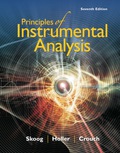
Principles of Instrumental Analysis
7th Edition
ISBN: 9781337468039
Author: Skoog
Publisher: Cengage
expand_more
expand_more
format_list_bulleted
Question
Chapter 25, Problem 25.11QAP
Interpretation Introduction
Interpretation:
Scan rate at experiment 2 should be calculated.
Concept introduction:
The peak current can be represented as follows:
Here,
Ip = peak current
n = number of electrons transferred in the redox event
A = electrode surface area
C = concentration
D = diffusion coefficient
V = scan rate
Expert Solution & Answer
Want to see the full answer?
Check out a sample textbook solution
Students have asked these similar questions
How long will it take to dissolve 2 mg of metal A (atomic weight 100) in a solution
containing A2+ from a metal electrode with area of 1.5 cm2 at an overpotential of
= 0.2 V? The exchange current density (j0) for A is 3x10-3 A/cm2, the temperature
T=298 K and the symmetry factor =0.4.
Exactly 6.00 ml of acetic acid (density = 1.05 g/mL), MW =60.05) was added to a 1 –liter volumetric flask, and the flask was filled to the mark with distilled water. A portion of the resulting solution was added to a conductance cell (k = 1.25 cm-1), and the conductance was found to be 416 μS. Calculate the dissociation constant Ka of acetic acid. ΛoH+= 349.8 Scm2/mole and ΛoCH3COO- = 41 Scm2/mole
An analyst wants to find out the active surface of his electrode before conducting his analyzes. To do this, he carried out a series of measurements by cyclic voltammetry (CV) using a 1 mM solution of K4Fe(CN)6 dissolved in 0.1M NaCl. He recorded the anodic peak intensity (ip) corresponding to the oxidation of Fe(II) to Fe(III) as a function of the scanning speed (v) of the CV (see table). What is the active surface of the electrode?
Data: Fe diffusion coefficient (CN)64-, D = 6.67x10-6 cm2/s
Randles-Sevcik equation ip = (2,69x105)n3/2ACD1/2v1/2
rate (v/s)
ip (A)
5,00E-02
5,75E-05
1,00E-01
7,68E-05
2,00E-01
9,94E-05
5,00E-01
1,42E-04
1,00E+00
2,07E-04
Chapter 25 Solutions
Principles of Instrumental Analysis
Knowledge Booster
Similar questions
- [3] The following Figure is the electrocapillary curves (A) and differential capacitance curves (B) for mercury in contact with 0.5 M Na,SO4 in the presence and absence of n-heptanol . 440- (A) (B) 420 Na,So. 400 Na, So, CHOH 360 Na so, 20 340- Na So, CH,OH 10 320 0.4 0.8 12 1.6 20 24 0.4 0.8 1.2 -EV ex NCE) 1.6 2.0 -EV e NCE (a) How do the curves in figure (A) relate to those in figure (B)? (b) What implications can be derived from the flat region in the electrocapillary curves in the presence of n-heptyl alcohol? (c) If we measure the electrocapillary curve of mercury in contact with 0.5 M Na,SO4 at higher temperature, what changes in the curve can be observed? Try to give explanation of these changes.arrow_forward3) Name the errors of glass electrodes in potentiometric measurements (please write correctly and concisely).arrow_forwardDiscuss the advantages, disadvantages, and limitations of the technique of cyclic voltammetry in both qualitative and quantitative measurements.arrow_forward
- The interaction between a basic analyte and the residual silanol groups of the stationary phase is minimized when the pH of the mobile phase used is equal to the pKa of silanol. True or False?arrow_forwardThe accuracy of a spectrophotometer can be evaluated by preparing a solution of 60.06-ppm K2Cr2O7 in 0.0050 M H2SO4 and measuring its absorbance at a wavelength of 350 nm using a cell with a pathlength of 1.00 cm. The absorbance should be 0.640. What is the molar absorptivity of K2Cr2O7 at this wavelength?arrow_forwardDoes KMNO4 oxidize or reduce an analyte during permanganimetry?arrow_forward
- An unknown cadmium(II) solution was analyzed polarographically by the method of standard additions. A 26.00-mL sample of the unknown solution produced a diffusion current of 1.77 µA. Following addition of a 6.00-mL aliquot of 4.76 × 10-3 M Cd²+ standard solution to the unknown solution, a diffusion current of 5.26 µA was produced. Calculate the concentration of Cd2+ in the unknown solution. Concentration = Marrow_forwardA solution containing 4.48 ppm KMnO4 exhibits 85.9 %T in a 1.00-cm cell at 520 nm. Calculate the molar absorptivity of KMnO4 at this wavelength.arrow_forwardA standard addition method for the voltammetric determination of Pb2+ involved addition of 5.00 mL of 0.800 x 10-3 M Pb2+ to one of two 25.00 mL aliquots of the sample. Supporting electrolyte and water were then added to each aliquot to give a final volume of 50.00 mL. Calculate the molar concentration of Pb2+ based on the following data Diffusion current of sample only = 78.3 uA A Diffusion current of sample with standard addition = 88.7 uAarrow_forward
- On a 0.109-mm-diameter column with a 0.813-μm-thick stationary phase, an unretained solute passes through the column in 2.16 min, while the analyte requires 8.29 min. Calculate the phase ratio, β, for this column. what is β? what is K (partition coefficient)?arrow_forwardA method for the analysis of Ca2+ in water suffers from an interference in the presence of Zn2+. When the concentration of Ca2+ is 100 times greater than that of Zn2+, an analysis for Ca2+ gives a relative error of +0.5%. What is the selectivity coefficient for this method?arrow_forwardWhat are two ways that a compound can be eluted from an ion-exchange column? What could be the advantages or disadvantages of each?arrow_forward
arrow_back_ios
SEE MORE QUESTIONS
arrow_forward_ios
Recommended textbooks for you
 Principles of Instrumental AnalysisChemistryISBN:9781305577213Author:Douglas A. Skoog, F. James Holler, Stanley R. CrouchPublisher:Cengage Learning
Principles of Instrumental AnalysisChemistryISBN:9781305577213Author:Douglas A. Skoog, F. James Holler, Stanley R. CrouchPublisher:Cengage Learning

Principles of Instrumental Analysis
Chemistry
ISBN:9781305577213
Author:Douglas A. Skoog, F. James Holler, Stanley R. Crouch
Publisher:Cengage Learning